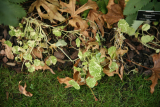Additional notes (click to expand)
Horticulture
Notes from our supplier: "1597. The flours are dispersed throughout the whole plant, of colour yellow with crossed star overthwart. The inside of a deep orange colour, unto the back-part of the same doth hange a taile or spure, as such as hath the larks-heel, but greater & the spur or heele longer."
Medicinal
Tropaeolum L. Tropaeolaceae cv Nasturtium. Distribution: South and Central America. As garden plants they are called nasturtiums, but the genus Nasturtium refers to plants, similar to watercress, in the Brassica family. The word 'nasturtium' whatever its usage comes from the Latin for a twisted nose, referring to the bitter taste that makes people's noses wrinkle. Tropaeolum comes from the Greek for a trophy, as Linnaeus thought the flowers climbing up columns resembled the Greek war trophies with golden helmets hanging on pillars (Stearn, 1994). The commonest horticultural species is T. majus; the flowers and leaves are edible, both raw and cooked, with a sharp, slightly bitter taste. This is due to a group of chemicals it shares with horseradish, wasabi, Brussels sprouts etc. called isothiocyanates, which are pest inhibitors in the living plants. T. tuberosum from the Andes is a root vegetable, cultivated and eaten like potatoes, also contains this chemical which means it can prosper without artificial insecticides, acaricides etc. Isothiocyanates have potential interest as adjuvants in anti-cancer treatments. Even more unusual is the reputation of T. majus for being an anaphrodisiac, a property that needs researching with the same enthusiasm as Marker and his colleagues showed when promoting the oestrogens and progestogens (synthesised from Mexican yams) as contraceptives.
Oakeley, Dr. Henry F. (2013). Wellcome Library notes.
link
Nasturtium has long been used in Andean herbal medicine as a disinfectant and wound-healing herb, and as an expectorant to relieve chest conditions. All parts of the plant appear to be antibiotic and an infusion of the leaves can be used to increase resistance to bacterial infections and to clear nasal and bronchial catarrh. The remedy seems to both reduce catarrh formation and stimulate the clearing and coughing up of phlegm[Chevallier. A. The Encyclopedia of Medicinal Plants Dorling Kindersley. London 1996].
https://pfaf.org https://pfaf.org/user/plant.aspx?LatinName=Tropaeolum+majus
Nomenclature
Not a recognised name by the RHS. Seed received from the supplier as Nasturtium Tall Climbing.
The word 'nasturtium' whatever its usage comes from the Latin for a twisted nose, referring to the bitter taste that makes people's noses wrinkle. Tropaeolum comes from the Greek for a trophy, as Linnaeus thought the flowers climbing up columns resembled the Greek war trophies with golden helmets hanging on pillars (Stearn, 1994).
Oakeley, Dr. Henry F. (2013). Wellcome Library notes.
link
Tropaeolum majus L.
Family: TROPAEOLEACEAEGenus: Tropaeolum
Species: majus L.
Habit: Annual
Hardiness: H2 - Tender; cool or frost-free greenhouse
Habitat: Garden origin
Garden status: Currently grown
Garden location: Southern Hemisphere Wolfson bed (N), seed waiting to be sown or germinating in greenhouse or frame (seed)
Flowering months: June, July, August, September, October
Reason for growing: Medicinal, other use
